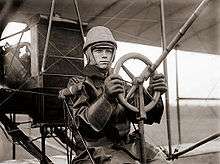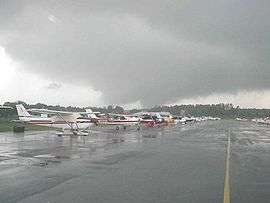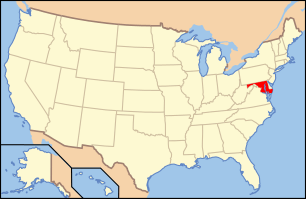College Park Airport
| College Park Airport | |||||||||||
|---|---|---|---|---|---|---|---|---|---|---|---|
| IATA: CGS – ICAO: KCGS – FAA LID: CGS | |||||||||||
| Summary | |||||||||||
| Airport type | Public | ||||||||||
| Operator | Maryland-National Capital Park & Planning Commission | ||||||||||
| Location | College Park, Maryland | ||||||||||
| Elevation AMSL | 48 ft / 14.6 m | ||||||||||
| Coordinates | 38°58′50.1″N 76°55′20.3″W / 38.980583°N 76.922306°WCoordinates: 38°58′50.1″N 76°55′20.3″W / 38.980583°N 76.922306°W | ||||||||||
| Website | http://collegeparkairport.aero/ | ||||||||||
| Map | |||||||||||
 CGS Location of airport in Maryland | |||||||||||
| Runways | |||||||||||
| |||||||||||
|
College Park Airport | |
|
College Park Aviation Museum, December 2008 | |
| Nearest city | College Park, Maryland |
|---|---|
| Built | 1908 |
| NRHP Reference # | 77001522[1] |
| Added to NRHP | September 23, 1977 |


College Park Airport (IATA: CGS, ICAO: KCGS, FAA LID: CGS) is a public airport located in the City of College Park, in Prince George's County, Maryland, USA. It is the world's oldest continuously operated airport.[2] The airport is located south of Paint Branch and Lake Artemesia, east of U.S. Route 1 and the College Park Metro/MARC station and west of Kenilworth Avenue.
History
College Park Airport was established in August 1909 by the United States Army Signal Corps to serve as a training location for Wilbur Wright to instruct two military officers to fly in the government's first airplane. Leased on August 25, the first airplane, a Wright Type A biplane, was uncrated and assembled on October 7. Civilian aircraft began flying from College Park Airport as early as December 1911, making it the world's oldest continuously operated airport. In 1977 the airport was added to the National Register of Historic Places.[1][3]
College Park Airport is home to many "firsts" in aviation, and is particularly significant for the well-known aviators and aviation inventors who played a part in this field's long history. In 1909 Wilbur Wright taught Lieutenants Frederic Humphreys and Frank Lahm. Humphreys became the first military pilot to solo in a government airplane. The same year on 27 October, Mrs Ralph Henry Van Deman was flown by Wilbur Wright to become the first woman to fly in a powered aircraft in the United States.[4]
Civilian aviation began at College Park with Rex Smith, an inventor and patent attorney, who operated the Rex Smith Aeroplane Company. Paul Peck and Tony Jannus were associates of his.
In April 1910, the Aero Club of America chapters from Washington and Baltimore chose the College Park Airport for the next James Gordon Bennett Race. $11,000 was raised locally of the $100,000 prize. Belmont Park in New York was chosen instead for the October meet.[5]
The Christmas Aeroplane Company of Washington, D.C., built its first aircraft, the "Red Bird II" at College Park Airport with a claimed flight on 15 October 1911. The "Red Bird III" was built in the spring of 1912, with a contract from the U.S. Postal service to deliver Air Mail.[6]
In 1911 the nation's first military aviation school was opened at College Park, with newly trained pilots then-Lt. Henry H. Arnold and Lt. Thomas DeWitt Milling as Wright pilot instructors and Capt. Paul W. Beck as the Curtiss instructor. William Starling Burgess also brought a licensed Wright Model B named the Burgess Model F.[7] The military aviation school saw numerous aviation firsts. Shortly following the cancellation of an international air meet at the airport in the fall of 1912, all aviators on the field participated in a demonstration for the International Congress of Hygiene participants.[8]
On 7 October 1912 Bernetta Adams Miller became the first woman to demonstrate a flight in a military aircraft.
In 1915 Cecil Peoli, one of the world's first professional aviators, died testing his 12-cylinder Rausenburger-powered biplane at College Park in preparation for New York and St. Louis cross country flights.[9]
In 1918, after a three-month trial with the War Department beginning May 15, the Post Office Department inaugurated the first Postal Airmail Service from College Park, serving Philadelphia and New York City (Belmont Park). Flights from College Park continued until 1921. The compass rose and original airmail hangar remain at the modern airport as a witness to this history. The Airport Code "CGS" originally referred to the airport's purpose in the 1930s as an airmail station. CGS = "ColleGe Station".
In 1920 Emile and Henry Berliner (father and son) brought their theories of vertical flight to the field and in 1924 made the first controlled helicopter flight.
From 1927 until 1933, the Bureau of Standards developed and tested the first radio navigational aids for use in "blind" or bad weather flying. This was the forerunner of the modern Instrument Landing System used today by aircraft.
In 1937 the Engineering & Research Corporation (ERCO), based in nearby Riverdale, Maryland, used the airport to test fly the early model of the Ercoupe, an airplane designed to be spin-proof.
George Brinckerhoff took over management of the Airfield and ran it from 1927 until 1959, hosting numerous airshows and teaching hundreds of pilots to fly during his tenure.[10]
The Maryland-National Capital Park and Planning Commission (M-NCPPC) purchased the Airport in 1973 and it was added to the National Register of Historic Places in 1977. A small museum was established in 1981 drawing 400-500 visitors on a weekend. Today it is run as both a historic site and operating airport whose history is depicted in the 27,000 sq ft (2,500 m2) College Park Aviation Museum.
Since the 9/11 attacks, and owing to the airport's proximity to the national capital, the operations of the airport have been severely restricted by the Transportation Security Administration in the interest of national security, but civilian pilots are still free to use the airport after going through a one-time background check procedure.
In 2015 Southern Management proposed an 233-foot, 13-story hotel on University of Maryland property in the approach path of the airport. The project was approved by the county but exceeded a 198 foot tall FAA limit for a building at location in the flight path, prompting a redesign.[11][12][13] Ground was broken for the hotel later in 2015.
Facilities
Airport facilities
College Park Airport covers 70 acres (28 ha) and has one runway:
- Runway 15/33: 2,607 by 60 feet (795 m × 18 m), Surface: Asphalt
The road to the airport is named in honor of Corporal Frank S. Scott, who was the first US enlisted man to die in a military aircraft, an accident which occurred at this airfield.
College Park Aviation Museum
The College Park Aviation Museum first opened to the public in 1981, and houses antique and reproduction aircraft associated with the history of College Park Airport. The current museum building opened on September 12, 1998, and includes a 90-seat auditorium, a non-circulating appointment-only library, gift shop, museum offices, and a replica of the original 1909 College Park Airport hangar, in addition to a main hangar with aircraft and exhibits on display.[14] Artifacts and hands-on activities highlight the aviators, aircraft builders and airplanes that operated at the airport. Aircraft on display are:
- 1910 Wright Model B (replica)
- 1911 Curtiss Model D (replica)
- 1912 Blériot XI (replica)
- 1916 Curtiss JN-4D "Jenny"
- 1924 Berliner Helicopter No. 5
- 1932 Monocoupe 110
- 1936 Taylor J-2
- 1939 Taylorcraft BL-65
- 1941 Boeing-Stearman Model 75
- 1946 Erco Ercoupe 415D
The museum offers changing exhibits, special events, lectures, workshops and programs for the public, schools and groups. There are also an extensive library and archives which hold materials relating to the airport's history, early aviation history, especially relating to Maryland, and general aeronautics including related children's books.[15] The museum is an affiliate of the Smithsonian Institution.[16]
References
- 1 2 National Park Service (2008-04-15). "National Register Information System". National Register of Historic Places. National Park Service.
- ↑ Grier, Peter (2009). "The College Park Century". AIR FORCE Magazine. 92 (September): 86. Retrieved 18 Sep 2009.
- ↑ William A. Aleshire and Robert F. Sellers (August 1976). "National Register of Historic Places Registration: College Park Airport" (PDF). Maryland Historical Trust. Retrieved 2015-08-01.
- ↑ Nick Komos (August 1989). "Only Yesterday". Air Progress: 60.
- ↑ Tom D. Crouch. "Aero Club of Washington: Aviation in the Nation's Capital, 1909-1914": 44.
- ↑ Thomas C. Parramore. First to Fly: North Carolina & the Beginnings of Aviation.
- ↑ "ARMY AVIATION SCHOOL IS ONE MONTH OLD TODAY Great Improvements Have Been Made at College Park Since Its Opening-Four Hangars Equipped to House Machines and Crews. Medical Corps Has Detail Stationed on Grounds.". The Washington Post. 23 July 1911.
- ↑ "NO AVIATION MEET HERE.: Col. Scriven, of Signal Corps, Says Plans Have Been Abandoned.". The Washington Post. 18 September 1912.
- ↑ Aerial age. 19 April 1915. Missing or empty
|title=(help) - ↑ Eugune L. Meyer (21 September 1995). "'Field of Firsts' Lands a Museum: Wright Brothers, Aviation School Enrich History of College Park Airport". The Washington Post.
- ↑ Luz Lazo (5 February 2015). "A proposed luxury hotel in College Park was considered a possible hazard for air traffic". The Washington Post.
- ↑ Joe Zimmermann (4 February 2015). "UMD construction projects could limit historic College Park Airport use". The Diamondback.
- ↑ "Saving Airports". AOPA Pilot: 96. February 2015.
- ↑ "Recent History". Retrieved 15 February 2015.
- ↑ "Library". Retrieved 15 February 2015.
- ↑ "College Park Aviation Museum - USAF.com". USAF.com. Retrieved 15 Jul 2011.
External links
- College Park Airport Main Website
- M-NCPPC College Park Airport
- College Park Aviation Museum
- Aviation: From Sand Dunes to Sonic Booms, a National Park Service Discover Our Shared Heritage Travel Itinerary
- College Park Airport in the early 1930s (with photos)
- Resources for this airport:
- FAA airport information for CGS
- AirNav airport information for KCGS
- ASN accident history for CGS
- FlightAware airport information and live flight tracker
- NOAA/NWS latest weather observations
- SkyVector aeronautical chart, Terminal Procedures
- College Park Airport, Prince George's County, Inventory No.: PG:66-4, including aerial photo in 1937, at Maryland Historical Trust website

